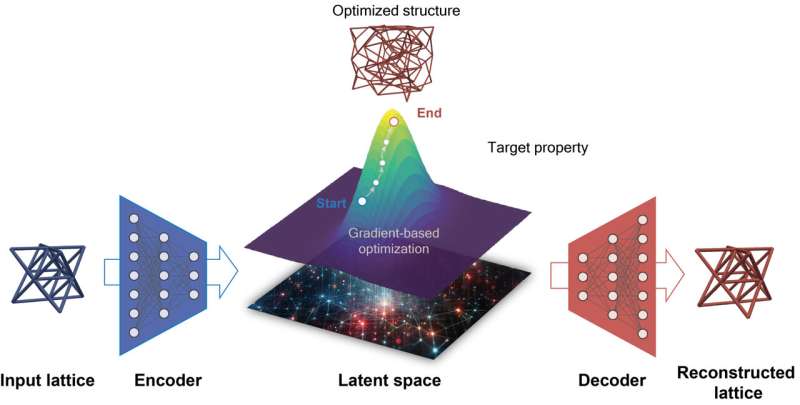This article has been reviewed according to Science X's editorial process and policies. Editors have highlighted the following attributes while ensuring the content's credibility:
fact-checked
peer-reviewed publication
trusted source
proofread
Artificial intelligence for safer bike helmets and better shoe soles

Bike helmets that absorb the energy of an impact, running shoes that give you an extra boost with every step, or implants that behave just like natural bone. Metamaterials make such applications possible. Their inner structure is the result of a careful design process, following which 3D printers produce structures with optimized properties.
Researchers led by Dennis Kochmann, Professor of Mechanics and Materials in the Department of Mechanical and Process Engineering at ETH Zurich, have developed novel AI tools that bypass the time-consuming and intuition-based design process of metamaterials. Instead, they predict metamaterials with extraordinary properties in a rapid and automated fashion.
A novelty, their framework applies to large (so-called non-linear) loads, e.g., when a helmet absorbs major forces during an impact.
Kochmann's team has been among the pioneers in designing small-scale cellular structures (similar to beam networks in timber-frame houses) to create metamaterials with specific or extreme properties. "For example, we design metamaterials that behave like fluids: hard to compress but easy to deform. Or metamaterials that shrink in all directions when compressed in a particular one," explains Kochmann.
Efficient, optimal material design
The design possibilities seem endless. However, the full potential of metamaterials is far from realized, since the design process is based on experience, involving trial and error. Furthermore, small changes in the structure can give rise to huge changes in properties.
In their recent breakthrough, the researchers succeeded in using AI to systematically explore the abundant design and mechanical properties of two types of metamaterials. Their computational tools can predict optimal structures for desired deformation responses at the push of a button.
The key is the use of large datasets of the deformation behavior of real structures to train an AI model that not only reproduces data but also generates and optimizes new structures. By leveraging a method known as "variational autoencoders," the AI learns the essential features of a structure from the large set of design parameters and how they result in specific properties.
It then uses this knowledge to generate a metamaterial blueprint whenever the researchers specify its desired properties and requirements.
Assembling building blocks
Li Zheng, a doctoral student in Kochmann's group, trained an AI model using a dataset of one million structures and their simulated response. "Imagine a huge box of Lego bricks—you can arrange them in countless ways and, over time, learn design principles. The AI does this extremely efficiently and learns essential design features and how to assemble the building blocks of metamaterials to give them a particular softness or hardness," says Zheng.
Unlike prior approaches using a small catalog of building blocks as the basis for design, the new method gives the AI freedom to add, remove, or move building blocks around almost arbitrarily.
Together with Sid Kumar, an assistant professor at TU Delft and a former member of Kochmann's team, they showed in a recently published paper that the AI model can even go beyond what it has been trained to do and predict structures that are far better than anything ever generated before.
Learning from the movies
Jan-Hendrik Bastek, also a doctoral student in Kochmann's group, used a different approach to achieve something similar. He used a method originally introduced for AI-based video generation, which has become commonplace: if you type in 'an elephant flying over Zurich,' the AI generates a realistic video of an elephant circling the Fraumünster Church. Bastek trained his AI system using 50,000 video sequences of deforming 3D-printable structures.
"I can insert the trajectory of how I want the structures to deform, and the AI produces a video of the optimal structure and the complete deformation response," explains Bastek. Most previous approaches have focused on only predicting a single image of the optimal structure. However, giving the AI videos of the entire deformation process is crucial to retain accuracy in such complex scenarios.
Based on the video sequences, the AI can create blueprints for new materials, taking into account highly complex scenarios.
Big benefits for bike helmets and shoe soles
The researchers have made available their AI tools to the metamaterials community. This will hopefully lead to the design of many new and unusual materials. The tools are opening new avenues for the development of protective equipment such as bicycle helmets and for further applications of metamaterials from medical engineering to soft robotics.
Even shoe soles can be designed to absorb shocks better when running or to provide a forward boost when stepping down. Will AI completely replace the manual engineering design of materials? "No," laughs Kochmann. "Used well, AI can be a highly efficient and diligent assistant, but it must be given the right instructions and the right training—and that requires scientific principles and engineering know-how."
The work is published in the journals Nature Machine Intelligence and Nature Communications.
More information: Jan-Hendrik Bastek et al, Inverse design of nonlinear mechanical metamaterials via video denoising diffusion models, Nature Machine Intelligence (2023). DOI: 10.1038/s42256-023-00762-x
Li Zheng et al, Unifying the design space and optimizing linear and nonlinear truss metamaterials by generative modeling, Nature Communications (2023). DOI: 10.1038/s41467-023-42068-x

















